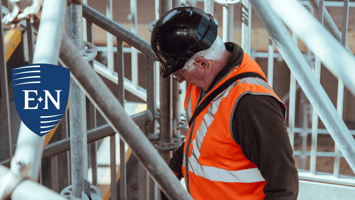Safety, and safety consulting, isn’t just about checking boxes — it’s about protecting your people...
Construction and General Industry Slips, Trips and Falls Prevention Guide

Understanding the Risks of Slips, Trips and Falls
Construction and general industries face a significant number of workplace accidents attributed to slips, trips, and falls. Understanding these risks is the first step toward prevention.
Slips usually occur when there's a loss of traction between the shoe and the walking surface, while trips happen due to an obstruction or an unexpected change in the walking surface. Falls can result from either slips or trips but also from a sudden loss of balance at heights. These incidents not only pose a threat to workers' safety but also lead to costly downtime, raise your E-Mod rate and insurance premiums, and can impact a company's reputation.
Educating employees about the common causes and potential hazards associated with these accidents is crucial. Regular risk assessment and the implementation of control measures can dramatically reduce the likelihood of such events occurring. Awareness campaigns and training sessions should be conducted to emphasize the importance of vigilance in maintaining a safe working environment.
Essential Gear: Choosing the Right Safety Equipment
The selection of appropriate safety equipment is vital in preventing workplace injuries from slips, trips, and falls. Essential gear includes non-slip footwear, harnesses, safety nets, guardrails, and other personal protective equipment (PPE). The right footwear can provide the necessary grip to prevent slips on slick surfaces, while harnesses and other fall arrest systems are crucial for height-related work. It is important to ensure that all PPE is regularly inspected for wear and tear and replaced as needed. Employees must be trained on the correct use of this gear to ensure their safety.
Employers should not only provide the necessary equipment but also ensure that workers are fitted correctly and that all gear meets the industry safety standards. Regular training updates and equipment checks can help maintain a high level of safety compliance on site.
Ladder Safety: Preventing Falls
Ladders are a common piece of equipment on construction sites, making ladder safety a critical component of fall prevention. Ensuring that ladders are in good condition, securely placed, and used properly can prevent many accidents. Workers should be trained on choosing the right ladder for the job, inspecting it before use, and following proper climbing techniques – such as maintaining three points of contact at all times.
Additionally, harnessing yourself when needed and implementing a buddy system where one worker steadies the ladder while another climbs can further enhance safety. Ladder safety training should be a mandatory part of employee education to instill safe practices from the outset.

Keeping the Site Safe: Best Practices for Construction
A safe construction site is well-organized, with clear pathways and properly stored materials. Keeping work areas free of debris, spills, and loose cables is essential to minimize the risk of slips, trips, and falls. Signage should be used to warn of potential hazards, such as wet floors or uneven terrain. Regular site inspections can identify potential problem areas that require immediate attention.
Best practices also involve the use of barriers and covers over holes and the implementation of strict housekeeping rules. By maintaining an orderly work environment, the likelihood of accidents can be significantly reduced.
Don't Forget Falling Objects
In addition to preventing falls from heights, it is equally important to secure tools, materials, and other items to prevent them from falling and injuring workers below.
Proper storage solutions and tethering tools can help mitigate these risks. Implementing strict protocols for securing items at height ensures that nothing becomes a hazard to those below. This is a critical aspect of site safety that should be rigorously enforced and regularly reviewed.
Monitoring and Responding: The Importance of Incident Reporting
A proactive approach to safety includes monitoring for potential risks and responding quickly to any incidents. Incident reporting is an essential component of this approach, as it allows for the tracking of near-misses and accidents, providing data that can be used to improve safety measures. A well-established incident reporting system fosters an environment where employees feel responsible for their safety and that of their coworkers.
Incorporating regular reviews of incident reports into safety meetings can highlight trends and areas for improvement. This ongoing monitoring and response system is a cornerstone of an effective safety program.
Building a Culture of Safety: The Role of Employee Education
The foundation of a safe workplace is a strong culture of safety, which begins with comprehensive employee education. By joining networks like Ellerbrock-Norris' ENCORE Safety Network, organizations can benefit from a wealth of resources and collective knowledge to enhance their safety programs. Such networks provide access to ongoing training, best practices, and support systems that emphasize the importance of every individual's role in maintaining a safe working environment.
Encouraging active participation in safety education programs ensures that employees are not only aware of the procedures but are also invested in their implementation. This collective commitment to safety can lead to a significant reduction in workplace accidents, creating a more secure and productive working environment for everyone.





